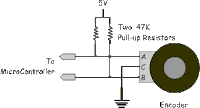DS1307 is a hardware realtime clock, which works on I2C protocol.
Better graphics using the same old fashioned alphanumeric LCD
(type HD44780). Icons which shows the status for Alarm ON/OFF
state, which gives a nice and cute look to the clock.

PIC Digital Clock Timer
This clock timer uses a PIC16F628 microcontroller to display 3
and 1/2 digit time and control an external load. The clock includes
a calendar with leap year and optional daylight savings adjustments.
The timer output can be set from 1 to 59 minutes and manually
switched on and off. The clock also has a correction feature that
allows an additional second to be added every so many hours to
compensate for a slightly slow running oscillator. The oscillator
uses a common 32.768 KHz watch crystal and the frequency can
be adjusted slightly with the 24pF capacitor on the right side of the
crystal.

PIC Digital Multiple Clock Timer
This circuit uses the PIC16F628 microcontroller to provide 4
timed outputs that can be programmed from 1 minute to 1 week.
An extra 8 bit shift register (74HC164) is used for the 4 timer
outputs and to display four additional indicator lights.

Digital Clock with Timer and Solar Panel Regulator
This is a combination digital clock timer and solar panel charge
controller used to maintain a deep cycle battery from a solar panel.
The timer output is used to control a 12 volt load for a 32 minute
time interval each day. Start time is set using 9 dip switches and
ends 32 minutes later. The 32 minute duration is set by selecting
the 5th bit (2^5 = 32) of a 4040 binary counter (pin 2). The timer
also has a manual toggle switch so the load can be manually
switched on or off and automatically shuts off after 32 minutes.
The time duration can be longer or shorter (8,16,32,64,128,256
minutes etc.) by selecting the appropriate bit of the counter.
The timer circuit is shown in the lower schematic just above the
regulator.
in which are contained all the circuits that need. The IC1
collaborates with six Display of common anode, that are not
critically as materials. You can select what dimension, you want
it is enough you adapt pins their in the circuit. The display are
drive by a system of polyplexis and are drive by thirteen
transistors. For timing the circuit, is used the frequency of
network (50HZ). This solution is the simplest, that it is not best.
For more constant frequency you can use a circuit that would
be based on crystal,


























































